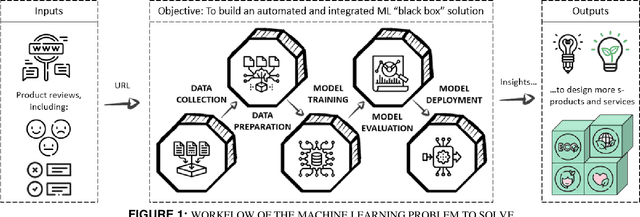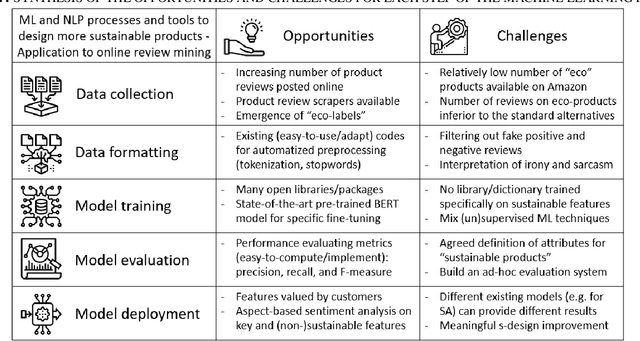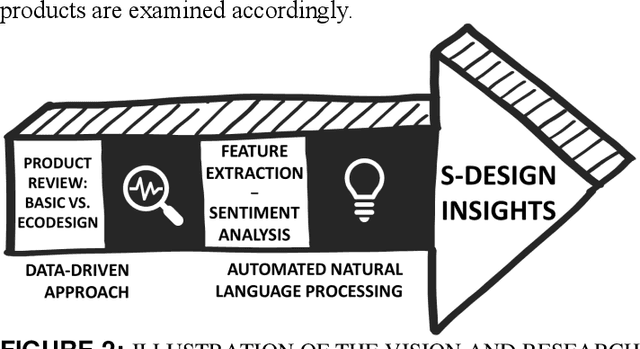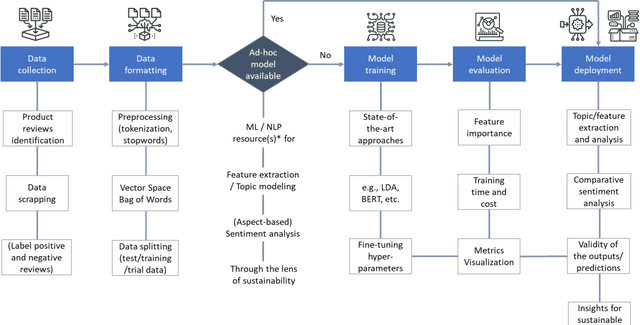Bernard Yannou
LGI
Can Machine Learning Tools Support the Identification of Sustainable Design Leads From Product Reviews? Opportunities and Challenges
Dec 17, 2021



Abstract:The increasing number of product reviews posted online is a gold mine for designers to know better about the products they develop, by capturing the voice of customers, and to improve these products accordingly. In the meantime, product design and development have an essential role in creating a more sustainable future. With the recent advance of artificial intelligence techniques in the field of natural language processing, this research aims to develop an integrated machine learning solution to obtain sustainable design insights from online product reviews automatically. In this paper, the opportunities and challenges offered by existing frameworks - including Python libraries, packages, as well as state-of-the-art algorithms like BERT - are discussed, illustrated, and positioned along an ad hoc machine learning process. This contribution discusses the opportunities to reach and the challenges to address for building a machine learning pipeline, in order to get insights from product reviews to design more sustainable products, including the five following stages, from the identification of sustainability-related reviews to the interpretation of sustainable design leads: data collection, data formatting, model training, model evaluation, and model deployment. Examples of sustainable design insights that can be produced out of product review mining and processing are given. Finally, promising lines for future research in the field are provided, including case studies putting in parallel standard products with their sustainable alternatives, to compare the features valued by customers and to generate in fine relevant sustainable design leads.
Mining customer product reviews for product development: A summarization process
Jan 13, 2020



Abstract:This research set out to identify and structure from online reviews the words and expressions related to customers' likes and dislikes to guide product development. Previous methods were mainly focused on product features. However, reviewers express their preference not only on product features. In this paper, based on an extensive literature review in design science, the authors propose a summarization model containing multiples aspects of user preference, such as product affordances, emotions, usage conditions. Meanwhile, the linguistic patterns describing these aspects of preference are discovered and drafted as annotation guidelines. A case study demonstrates that with the proposed model and the annotation guidelines, human annotators can structure the online reviews with high inter-agreement. As high inter-agreement human annotation results are essential for automatizing the online review summarization process with the natural language processing, this study provides materials for the future study of automatization.
Mining Changes in User Expectation Over Time From Online Reviews
Jan 13, 2020



Abstract:Customers post online reviews at any time. With the timestamp of online reviews, they can be regarded as a flow of information. With this characteristic, designers can capture the changes in customer feedback to help set up product improvement strategies. Here we propose an approach for capturing changes of user expectation on product affordances based on the online reviews for two generations of products. First, the approach uses a rule-based natural language processing method to automatically identify and structure product affordances from review text. Then, inspired by the Kano model which classifies preferences of product attributes in five categories, conjoint analysis is used to quantitatively categorize the structured affordances. Finally, changes of user expectation can be found by applying the conjoint analysis on the online reviews posted for two successive generations of products. A case study based on the online reviews of Kindle e-readers downloaded from amazon.com shows that designers can use our proposed approach to evaluate their product improvement strategies for previous products and develop new product improvement strategies for future products.
Using evolutionary design to interactively sketch car silhouettes and stimulate designer's creativity
Mar 21, 2013



Abstract:An Interactive Genetic Algorithm is proposed to progressively sketch the desired side-view of a car profile. It adopts a Fourier decomposition of a 2D profile as the genotype, and proposes a cross-over mechanism. In addition, a formula function of two genes' discrepancies is fitted to the perceived dissimilarity between two car profiles. This similarity index is intensively used, throughout a series of user tests, to highlight the added value of the IGA compared to a systematic car shape exploration, to prove its ability to create superior satisfactory designs and to stimulate designer's creativity. These tests have involved six designers with a design goal defined by a semantic attribute. The results reveal that if "friendly" is diversely interpreted in terms of car shapes, "sportive" denotes a very conventional representation which may be a limitation for shape renewal.
Separating Topology and Geometry in Space Planning
Mar 16, 2013



Abstract:We are dealing with the problem of space layout planning here. We present an architectural conceptual CAD approach. Starting with design specifications in terms of constraints over spaces, a specific enumeration heuristics leads to a complete set of consistent conceptual design solutions named topological solutions. These topological solutions which do not presume any precise definitive dimension correspond to the sketching step that an architect carries out from the Design specifications on a preliminary design phase in architecture.
 Add to Chrome
Add to Chrome Add to Firefox
Add to Firefox Add to Edge
Add to Edge